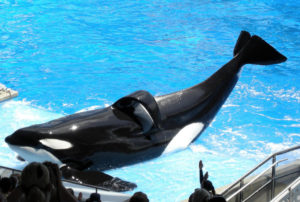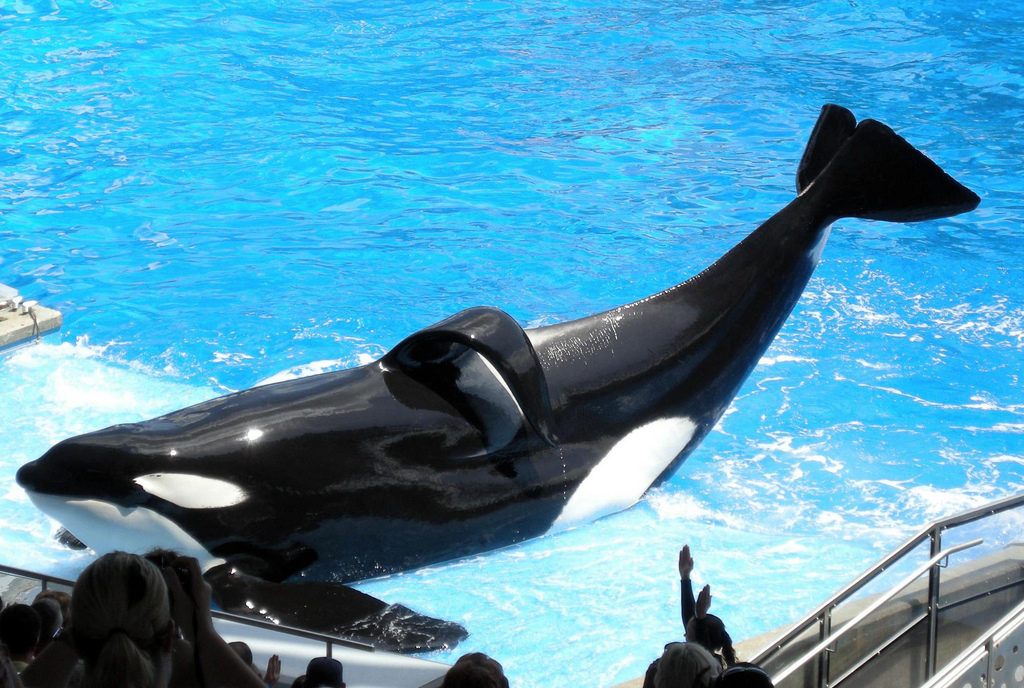
On January 6, 2017, SeaWorld Orlando announced the death of a 12,500 pound killer whale, Tilikum, “due to poor health.” According to Outside Magazine Tilikum died of bacterial pnuemonia. Tilikum had been held in captivity since 1983. Many saw his death as his release from bondage.
After his initial capture in Iceland, Tilikum was relocated to Sealand of the Pacific, a public aquarium in British Columbia. There Tilikum was trained as a performance animal. At first he fit nicely in the enclosure. As Tilikum grew, because of his great size, 6 tons and 22 feet, the space in which he lived became increasingly uncomfortable. The tension between Tilikum and the other whales in the space increased. The enclosure was “one small steel box, to be honest,” former Sealand trainer Christopher Porter admits in the noteworthy documentary Blackfish. The film did much to raise awareness of the dangers of the captivity of wild sealife. Eventually, conditions became unbearable for the three whale residents.
In February 1991, 20 year old part time orca trainer Keltie Byrne was killed after she slipped and fell into the whale pool following an afternoon show. “The cause of death listed was that she drowned accidentally, but she was pulled under by the whale,” claims one witness to the accident, Nadine Karlen. “It was the large whale. Tilikum, the male, he is the one that went after her, he was definitely the instigator.”
Shortly after the incident, Sealand of the Pacific was closed. All three whales were sold to SeaWorld in the United States. Tilikum was shipped to Orlando to become a performance animal at the Florida Sea World. “We all had this vision that [SeaWorld] knew more than us… so it was like ‘Okay, Tilly. You’re going to Disneyland! Lucky you!’” says Porter in regards to Tilikum’s departure.
Despite the death of Byrne, former trainers claim they had no idea that Tilikum was considered a dangerous animal. “We weren’t given the full details of Keltie’s situation,” says his former trainer, Jeffrey Ventre. Samantha Berg, another trainer, adds, “What I found really odd at first was that the way they were acting around this whale and what they had told us [about the circumstances of Byrne’s death] seemed to me to [suggest] two different things.” Tilikum seemed to thrive at SeaWorld. In 1992, soon after his arrival, Tilikum’s performance became the grande finale of the show.
It was seven years before Tillikum was involved in another death, that of Daniel P. Dukes. A visitor, Dukes allegedly stayed at the park after hours and climbed into the tank. He was found naked with numerous wounds and abrasions. However, this was not enough to ignite concern, as it was “the perfect story line. A mentally disturbed guy hides in the park after hours and strips off his clothes and decides he wants to have a magical experience with an orca and drowns,” says another former trainer of Tilikum, John Jett. Tilikum quickly returned to performing, likely due to the assumptions made based on Dukes’ mental state and poor judgement.
Tilikum’s third victim, Dawn Brancheau, was killed in 2010 during a show. Hers was arguably the most notable Seaworld death, shocking to the audience and workers. Because she was one of their best trainers, “Hearing that it was Dawn, I couldn’t believe it,” says former trainer, John Hargrove.
In an article in 2010 in Outside, Tim Zimmerman summarizes eyewitness accounts of Tilikum’s attack.
Brancheau was lying on a shelf beside the pool stroking Tilikum. “Tilikum took Brancheau’s drifting hair into his mouth. Brancheau tried to pull it free, but Tilikum yanked her into the pool. In an instant, a classic tableau of a trainer bonding with a marine mammal became a life-threatening emergency. She managed to break free and swim toward the surface, but Tilikum slammed into her. She tried again. This time he grabbed her. Her water shoes came off and floated to the surface. ‘He started pushing her with his nose like she was a toy,’ said Paula Gillespie, one of the visitors at the underwater window. SeaWorld employees urgently ushered guests away.” Tilikum kept dragging Brancheau through the water, shaking her violently
Brancheau’s autopsy revealed the complete mutilation of her body, including being scalped. Her arm had been severed from her body.
Yet the official reports of Brancheau’s death, as with the previous two victims, were at odds with the event. Some blamed Brancheau for her death because of her ponytail. After the incident, the ponytail was the main evidence used by Seaworld to defend itself in court against OSHA and to protect Seaworld’s performance funding. One executive claimed on live television that “Dawn, if she were standing here with me right now, would tell you it was her mistake.”
The trauma of captivity that many believe caused Tilikum’s lethal attacks on humans is what drives the animal rights activists’ positive reactions to his death; those who protested SeaWorld’s treatment of animals held up signs that read “Finally Free” after the orca’s death.
Many thank Blackfish made for revealing the reality of animal amusement parks. Blackfish was nominated for an Oscar in 2014.
SeaWorld announced shortly before Tilikum’s death that they were ending breeding of orcas. Tilikum sired 21 calves during his lifetime, eleven of which are still living in captivity. Even if the end of the enforced performance of killer whales is near, captivity for whales and other animals continues beyond SeaWorld.
How necessary is it to remove these animals from their own environments to educate park guests and inspire appreciation for these creatures? Could mediums like documentaries with a similar approach to Blackfish have the same educational value while preventing animal cruelty and the tragedies that struck Byrne, Dukes and Brancheau and their families?






